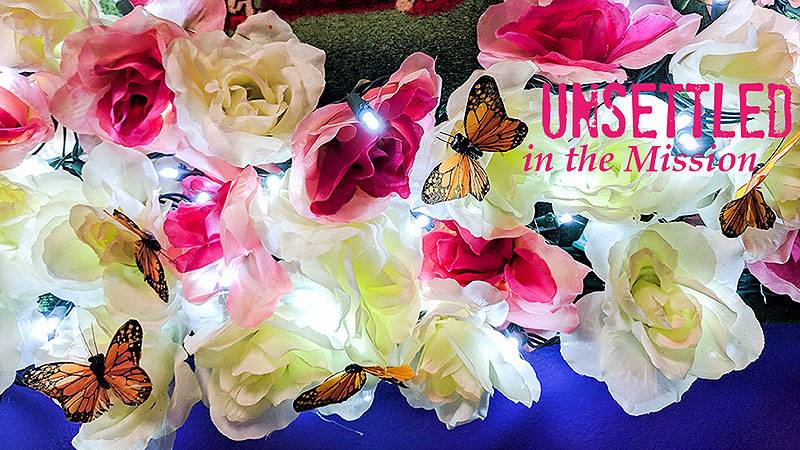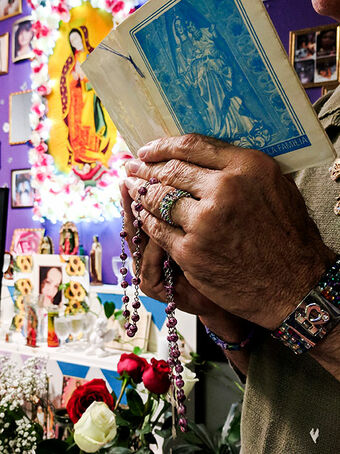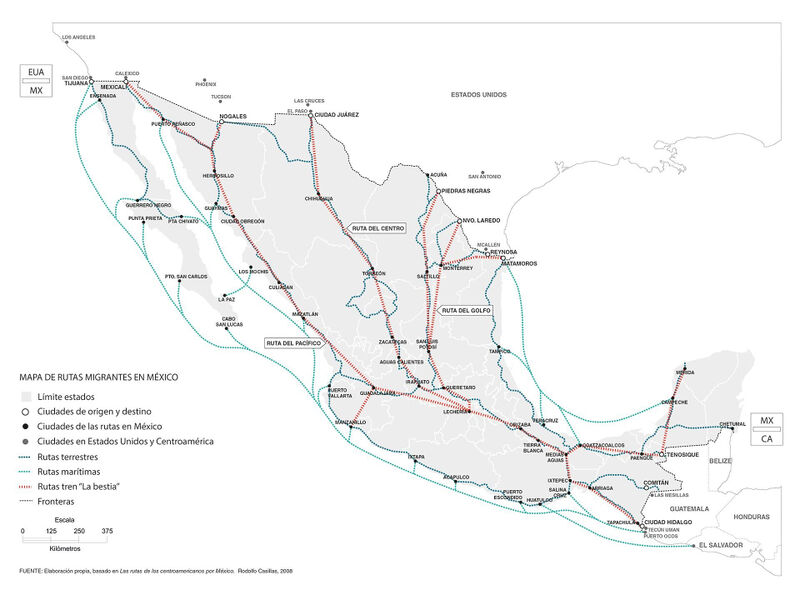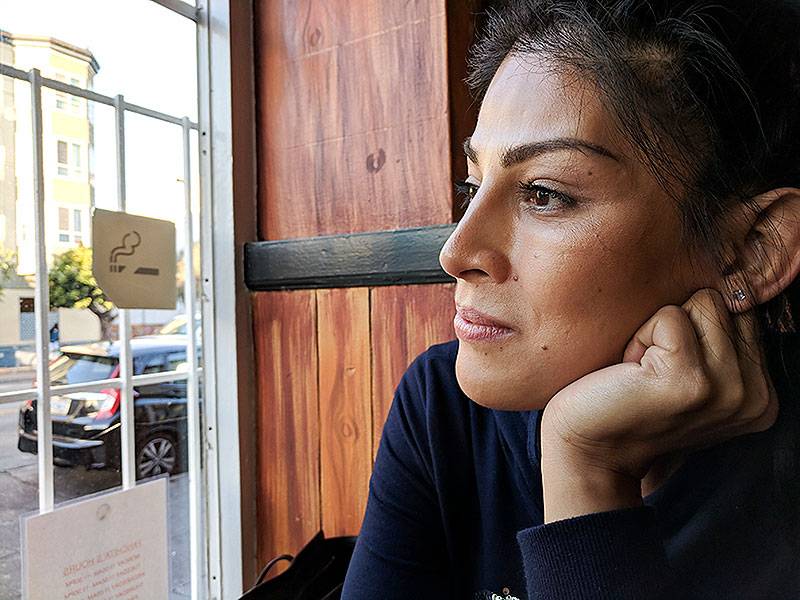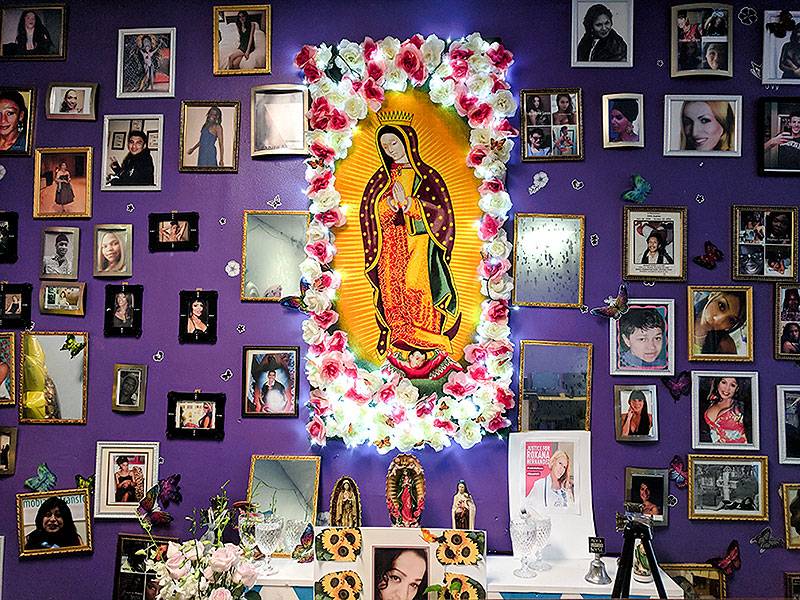Unsettled: The Girl Who Tamed the Beast
Historical Essay
by Adriana Camarena
Originally published in El Tecolote November 15, 2018
This is the journey of Barbie Niño. At the age of 11, she struck out alone from Honduras to board the train route known as “The Beast” that crosses the length of Mexico from the southern border with Guatemala to the U.S. border in the north. Niño was steely in her desire to reach the U.S. to live free to be herself. This is a story of fierce courage from a little one, as much as the kindness of many strangers who buffered this butterfly girl from more violent winds of fate. Now a beautiful young transwoman, 27 years of age with raven black hair, Barbie tells her tale to inspire little children who feel uniquely alone in the world—just like she once did—to keep hope lit, and eyes open for the tricksters, beasts and angels who will bend barriers for them along the way.
Niño Is Niña
Her family name is Niño. When she lived in Honduras, she was also just a “niño,” a little boy, who already knew she was a little girl. “My father knew. My little companions also accepted me. I was respected in my barrio,” she says. “My father would tell me, ‘Take care of yourself. Your life will not be easy.”’
Life was already not easy.
Niño lived with her father, her stepmother and her two teenage stepbrothers. “My traits were already evident. My discrimination started then.” There was a trench latrine that ran near their house, and Niño’s stepbrothers would wait until she was showering and fully soaped to lift and throw her naked into the foul pit for their perverse enjoyment.
“My stepmother was also a greater despot than others,” recalls Niño. One day, when Niño was eight and her father was out of town on a job, her wicked stepmother told her, “Mico! Cunt! You are an animal, you are lazy!” hitting her with a fist, “He is not your father; he is not your father!”
Her Father Who Is In Heaven
She remembers her father, shirtless, shoeless and in shorts, leaning in the doorway of their home, with a hot coffee (never a cold beverage) in his hand, enjoying the cooling tropical heat in the evenings after work in San Pedro Sula. She would play hide-and-go seek with the other children on the block, turning from time to time to look back at him, her protector, reassured that he was still there watching over her.
He died of a heart attack at 54 years of age, Niño was only 11. At her father’s wake, her uncle pulled her outside to the corner where her father had died and asked her, “What have you planned to do with your life?”
“I broke down weeping,” remembers Niño.
Cinderella Lived in Honduras
Her stepmother convinced Niño that she had changed her evil ways, so Niño stayed home with her. “My stepmother had a store. I had to be up at 5 a.m. to place bottles in the refrigerators, arrange meats and sausages, spray the street with water to keep the dust down. Then I would be back in the house preparing breakfast for them, cleaning the dishes, the stove, the rooms, the house… I was Cinderella. When I was older and finally saw the movie, I turned into an ocean of tears, because I identified.”
Taylor leads the rosary prayer at El/La for the soul of Janelle Ortiz, a trans Latina murdered in Laredo by a border patrol agent, on Sept. 21, 2018
Photo: Adriana Camarena
In the evening, Niño would head out to night school with only the exact change for her buses, and the promise of a beating if she asked for a cent more. The proverbial last drop the cup would soon runneth over.
The Journey Begins (San Pedro Sula, Honduras)
“I began my transition when I was 10 years old. I dressed like a girl. Only when I went to school did I dress in a boy’s uniform. There was another transwoman in the town. They would not let me speak to her, but I would meet with her in secret. I wanted breasts. She would give me contraceptive pills. At school, they started noticing my breasts. Someone told the director. He burst the little buttons of my white shirt and ripped my undershirt off, humiliating me in front of everyone, leaving me in ridicule. The teachers took a vote and decided I could not return to school. They said I was a freak, that I was going to corrupt my schoolmates, inciting their sexuality.”
One day, instead of packing her school books into her backpack, she packed a change of clothes and went to her grandmother’s house in Veracruz, Copan to say goodbye.
Goodbye, Abuela, the Only One Who Cares (Veracruz, Honduras)
Her abuelita, her grandmother, was named Irene. At dawn, Irene made bean empanadas for her to take on the road. “She told me to stay. I told her I was going to the United States of America,” says Niño. “But I reassured her, ‘Don’t worry abuela, you are the only one who cares about me.’” On the way out the door, Niño embraced her, “I felt the sound of her weeping against my chest, with so much pain and love. I could not turn my face up to look at her one last time. If I had looked at her, I would not have left.” With some gift money from an uncle in her pocket, Niño headed to the border of Guatemala.
Two-Spirit Trickster at the Black Christ Sanctuary (Esquipulas, Guatemala)
Just over the border from Honduras, there is a famous sanctuary in Esquipulas, Guatemala, with an ancient “Black Christ,” the wood of the figure cured by smoke offerings. “I entered the church in Esquipulas. It was smoky inside, with people walking on their knees. My abuela and I had dreamt of coming here together. My first impulse was to return to my grandmother and I ran outside to cry.”
Outside Niño came across a gay man, but he wasn’t openly gay. He was the first to call her “girl.”
“You are a girl.”
“I am not a girl.”
“You are a girl.”
Begging for change to pay the microbuses, they advanced town by town until they reached Escuintla, Guatemala. The Mexican border was still more than 300 miles away.
“I had a gold ring that was the only keepsake I had of my father. The [gay] man insisted he would keep it safe for me. I gave it to him. I never saw him again.”
Niño walked alone into town. “They were indigenous people. ‘Hueco, fag,’ they called me. ‘Go away. You will bring us bad luck. The milpas will not grow.’ I was run out of town. I walked down the dark highway at night feeling very afraid. I stopped a bus. It was a luxury bus. The driver let me on. I felt that I was nothing. So, I curled up on the steps just inside the bus. “’Not there,’” said the bus driver. He sent me to a full reclining seat, and I fell asleep all the way to Guatemala City.” In Guatemala City, the driver handed me off to another bus driver. ‘This bus will take you all the way to the border,’ he said. I slept again until the next day, when I woke up in Tecun Uman near the border of México. I had $5 Quetzales in my pocket.”
Niño waded across the Suchiate River between Guatemala and Mexico. On the other side, migrants directed her to the migrant shelter in Ciudad Hidalgo. The priest welcomed her, “I was never made to feel inferior.” The shelter allowed a 3-day stay.
The Girl Boards The Beast (Ciudad Hidalgo, Chiapas)
The Beast is unpredictable. Three days went by and the train did not pass. Niño met a group of five children travelling together. They were all minors but all older than her. She made herself useful to them by carrying their bags. “They never behaved badly towards me.” Together, they paid a hotel room. “It was the first time in my life I ever experienced hot water. We burned ourselves in the shower.”
The train started whistling its arrival from afar. At the railyards, over the next days, the train operators started assembling and disassembling wagons, moving the train back and forth on the rails, readying its departure. Niño and the awaiting migrants watched its movements. “The Beast was a huge yellow metal wall. I had never seen anything like it. My legs started to tremble. I cried. I panicked.”
The older children had a meeting and concluded, “Niño is afraid. Niño is very little. We will help Niño onto the train.”
When it was time to leave, the eldest among them went to the front of the train with Niño. As the train gathered speed, he suddenly lifted her into the air and she was snatched up by their companions who had already boarded further back. The older boy hopped on in the back and caught up.
“I rode in a nook between the wagons, watching over our bags.”
Jobita Takes Her In (Villa Comaltitlán, Chiapas)
In Villa Comatitlán, a rural town, Niño stayed to work under the care of Jobita. “I stayed months there, shelling corn into giant barrels. I was paid by the barrel.” Jobita’s son once harassed Niño for her gender identity, which led to a fight in which she bit him. “Jobita said it served him right.” But Niño was no longer comfortable.
On Sept. 15, Mexican Independence Day, with the sights, sounds and smell of firework powder in the air, Jobita ground cacao with sugar, packed it into wheels of chocolate, and saw Niño out to the highway. By then 12 years old, she resumed her journey, walking on the side of the highway to Escuintla.
Dust Ghost Walks to the River (Escuintla, Chiapas; Chahuites, Oaxaca)
In Escuintla, semi-trailers stop at the highway restaurants. Niño stowed away, curled up inside the spare tire that hung underneath a semi-trailer, exposed to the billowing dirt. Upon reaching Oaxaca, she crawled out.
Caked in dirt, she walked into the town of Chahuites. “It was dawn when I walked down the main street of the town, demanding to know ‘Where can I find a river?’ Everyone looked at me. I was a dust ghost.” Niño spent the rest of the day washing and drying her clothes and herself at the river. With the few cents she carried, she went to buy herself some tacos al pastor. The taquero told her. ‘Hide your money. This one is on me, but don’t tell anyone.’”
She then sat in front of a store, next to the train tracks, waiting for The Beast, drinking coffee and eating María cookies. Suddenly it was upon them. Carrying a little bag, she ran, struggling to make it on. Some cholos, homies, pulled her aboard.
You Are Muxe (Juchitán de Zaragoza, OAX to Orizaba, VER)
In Juchitán, she sat in the plaza, “wearing my little tiara, a pretty blouse and pants. People would come to me and fill my hands with food. They would tell me, ‘You are muxe.’”
Many years later, Niño would learn that among the matriarchal Zapotecan Indigenous peoples of Juchitán, transwomen are respected as a third gender, and known as “muxe.” “There was a family, who every day came to see me, give me food, and insist that I stay with them, because I was muxe.” But Niño would not deviate from her journey; a week later she reached Ixtepec, Oaxaca. Then Orizaba, Veracruz.
Mapa de las rutas de La Bestia, el tren que atraviesa México, creado por Arquitectos con la Gente, con informacion proporcionada por Rodolfo Casillas (2008).
In Orizaba, “the town was in a struggle with itself,” Niño explains. A Honduran migrant had raped the daughter of a volunteer at the migrant shelter. Half the town wanted to run them out, while the other half offered them food and champurrado to drink. In the cold and rain of Orizaba, her lips split White and a local woman dabbed Vaseline on her mouth.
Hungry and Cold (Lecheria, State of Mexico)
At a major train juncture at Lecheria, Niño fell in with other starving and frozen migrants following the train tracks. Along the way, they gleaned apples off wild trees. They caught the train through Mexico City. “As you advance north, the trains run faster. It is almost like a game. Each leg is harder.” They made their way to Queretaro, but jumped too early and walked for miles.
My Son Is Also A Migrant (San Juan, Queretaro)
At the edge of the town of San Juan, there was a small ranch. A woman approached them. “Don’t give them food,” cried out her husband, “They are migrants.” The woman paid him no heed, “We need to remember that our son is in the United States, and he may run into the same needs.”
Further into Queretaro, they caught The Beast again to San Luis Potosi. “I enjoyed everything I saw along my travels,” proclaims Niño.
Niño Meets the Devil (Saltillo, Coahuila)
In Saltillo, Coahuila, Niño stayed at a migrant shelter run by nuns. There she met “The Devil,” a Honduran man who was tasked by the nuns to smell the feet of the migrants, and send them off to the washroom if they didn’t pass the smell test.
“The nuns didn’t know where to place me with the women or the men. I would hear them speaking about me,” explains Niño.
“Did you help them decide?” I ask.
Niño smiles amused, “No, after a while, I was just called ‘Niño, Niño, Niño’ this and that.”
Niño made herself useful, washing clothes, cleaning bathrooms, and making money on errands to the town store for other migrants. She worked herself into the hearts of the nuns. They began making plans to order her school papers, so she could stay in Saltillo to study. October came around, then November. “We celebrated Day of the Dead by making giant train tracks from paper and wood to form an altar to the migrants who had died on their journey, killed by the train, killed by narcos, abandoned by coyotes in the desert. We carried candles and a priest said mass.”
One day The Devil came to Niño and said, “It’s time for us to go.” On the outskirts of Monterrey, people threw stones at the train. One caught Niño in the head, and she rode bloodied and unconscious all the way to Nuevo Laredo, where she woke up with a sweater wrapped around her head as a bandage.
Our Mermaid Drowns in the Río Grande (Nuevo Laredo, Mexico)
The migrant shelter in Nuevo Laredo was close to the Río Grande. Niño and The Devil befriended an assistant coyote. They learned of the one hour window they had to cross, during which the U.S. Border Patrol changed guard. On Nov. 24, Niño headed to the river with four others. As instructed, they linked arms to form a human chain to cross the river. “It is not deep, but it is freezing, and the undercurrent is very strong. The wind blows hard like it will take you away.”
At the deepest point, Niño found herself on tip toes on a single rock with the water up to her neck. In desperation to advance, someone pushed her forward, she lost her footing and was swept away. “I felt the waves, the rocks hitting my face. I prayed ‘Father, help me!’ as I was struck unconscious.”
Migrants down current fished her out of the water by her long hair. She woke to the feeling of water being pushed out of her lungs. The Devil found her and they walked all night, under the watchful brilliant eyes of real animal coyotes. Her knees were spiked by long cactus spines. In excruciating pain, she walked on, until they fell asleep under a tree. “Even the rocks felt like pillows at that moment.” When they awoke, Niño and The Devil realized that they had reached their destination: a fleamarket in Laredo, Texas called La Pulga (the flea).
Niño Lives Inside the Flea (Laredo, Texas, USA)
“We were welcomed as if we were being rewarded for making the crossing. Soon enough, we were sorted into jobs. I began cleaning the old stoves and dryers and appliances that would be put up for sale.” Margarita, who had a gay son, rented her a little room. “I had a little bed, a TV and a heater. It is so lovely to sleep with a heater. I watched my telenovela Rebelde (Rebel) in the evenings.”
One evening, The Devil called home and learned that he had left his girlfriend pregnant in Honduras. “He was so overjoyed that he got drunk that night. He was like my brother by then, and he hugged me tight. I only realized the next morning that he had stolen $80 dollars from my jacket. He left that same night for Honduras. But I could hardly be very mad at him, considering I was alive because of The Devil.”
Barbie Niño gazes out a window at Panchita’s Restaurant on 16th Street near Valencia, on Oct. 8, 2018.
Photo: Adriana Camarena
Many migrants living in La Pulga were skilled at jumping back and forth across Laredo and Nuevo Laredo for a night out on the town. One day Niño decided to join them. Crossing back to Texas, they got lost. Outside a school, someone called the Border Patrol on them. The honeymoon was over.
A Blessed Child Cocoon (San Antonio, Texas, USA)
By international law, foreign unaccompanied minors who cross into the United States can’t be deported to Mexico if that child is not from Mexico. After a series of intakes and holding cells in San Antonio and Nixon, Texas, Niño settled into life at a children’s detention center. “The walls were bright with colors and decorations. People were speaking English and I was so confused. It was another world.”
Niño talked to a lawyer and chose to request political asylum for being transgender. Children came and went from the center, returning to their families, but Niño stayed. “It was there that I met one of my greatest friends in the world. Her name is Sissy, she is from El Salvador. She was a trans-chica, 13 years old. It was very beautiful because there was someone like me, who understood me, and I learned that there were other people like me.” Sissy lives on the East Coast. They still stay in touch.
The center was run on strict meals, class and break schedules, but Niño didn’t mind. “I missed my grandmother, but I was finally living my childhood, belatedly. I loved my life there. My heart is crushed to think of the children in the detention centers today. That was not my experience. The president should be more humane towards children.”
The Butterfly Teen Flies the Cage (Miami, FL, Chicago, IL)
Niño turned into a butterfly teen, while her asylum case was still under consideration. Her final court date for her asylum case arrived. All the people who had taken care of Niño at the detention centers were present. The judge asked her a series of questions, then took a recess. When she returned 20 minutes later, she announced that she was granting Niño political asylum. “The judge asked me, ‘How do you feel?’” I said, ‘I don’t know what it means.’ The judge explained, ‘It means that at last you can be you, that you never have to worry again about being sent back to Honduras, that you will never be mistreated again by your stepbrothers.’ I was so excited that I started crying. I don’t mean to be dramatic, but everyone who had taken care of me was overjoyed. It was our triumph.” The judge gave her $50 out of her pocket to go celebrate at the fair across the street.
Ironically, her asylum approval meant she lost her known advocates. At the age of 14, she had already been transferred to a group home, and began attending regular middle school in San Antonio. She was no longer buffered from transphobia, she was bullied at school. With a language barrier, school was also harder. “I became depressed… I isolated myself.” The director of the group home also forced her to dress as a boy. “I felt psychologically traumatized.”
But our butterfly teen had come too far to let herself be trapped. During her time in the detention center, Niño received a daily dollar pension, which accumulated as a savings. One day, she walked to Walmart, purchased luggage, packed her papers, paid someone to buy her a ticket to Miami at the Greyhound terminal, and took off.
Two years later, she moved to Chicago, where she worked as a waitress at The Cave, a transbar. She was happy working there, until someone outed her as under-aged. Suddenly, she was unemployed and desperate. “I fell into sex work to survive.”
El/La para Translatinas (San Francisco, CA)
Her friend, Cristian, a gay man, convinced her to move together to gay-friendly San Francisco. “We rode the bus three days to the old Greyhound terminal in the City. I was looking more “fish” by then, more feminine. … We slept in the streets our first night in San Francisco, but by the next day, we found the Larkin Youth Services Shelter. …I was fortunate as a minor to be taken in there. There are no specialized shelters in San Francisco for adult transwomen.”
Soon enough, they were directed to 16th Street to Brothers of the Sun and Moon, a gay Latin center, and also to El/La for TransLatinas at the Redstone Building at 16th and Capp Streets.
A memorial altar is seen inside El/La for Translatinas, Redstone Building in San Francisco on Sept. 21, 2018.
Photo: Adriana Camarena
Barbie Finds Her Matriarch (San Francisco, CA)
El/La is an organization in the Mission serving transgender Latinas and Latinos and non-normative gendered individuals of Latin heritage. At El/La, Niño met Jiovana Luna, another trans-Latina. “She was only a volunteer, but she would go above and beyond to help us. There was a time when El/La lacked resources. Jiovana would take money from her own pocketbook to bring food to El/La. She was our matriarch; the one who would pull bread away from her lips to put into our mouths. I was 18 years old and she helped me start my hormonal treatment, find a clinic, finalize my residency process, change my name to Barbie Niño, and find a job. It was all because of Jiovana.”
Today, the community room at El/La is dominated by a beautiful memorial wall for transgendered community members. Many have died as a result of domestic violence, overdoses, suicide and hate crimes. Their portraits surround a grand image of the Virgin of Guadalupe, against a deep purple background. Jiovana died suddenly three years ago from a stroke. Her portrait is on the altar, looking out upon us with dark compassionate eyes, light skin and curly hair. Barbie remembers, “From the moment, we entered the doors of El/La, Jiovana would know if we were depressed. ‘Something is up with you. Come, let’s talk.’”
The Sky Is the Limit
A decade ago, El/La was constrained to a single office, and an assortment of rundown donated furniture. Today, under new leadership with Jessy D’Santos , the organization has gained more office space, and is expanding the services it provides. I spoke to Pauly Ruiz, El/La’s case manager, who explained the difficult challenges faced by trans women, many who have suffered extreme discrimination and violence. One of the greatest challenges is access to dignified employment. “Many trans women in conditions of vulnerability will rely on sex work to survive, in part because they are made to feel that sex work is the only space they can occupy,” explains Pauly.
Until recently, Barbie worked as a janitor, but since she will soon undergo a final cosmetic intervention, she is not working at the moment. She lives in a Tenderloin SRO with her two little dogs. I ask about her future plans, “I hope to become a flight attendant. I’ve already applied as a Cabinet Agent (a plane cleaner) and I passed all the preliminary tests, but I have never received a call back.” Barbie believes she was passed over for being transgender, but she will try again after she recovers from her operation. “I feel I am fulfilling my dreams.”
About Unsettled
Unsettled in the Mission is a series of literary non-fiction essays by Adriana Camarena to be published periodically as supplements in El Tecolote through January 2019. Her writing is based on portraits of the traditional working class and poor residents of the Mission District for an exploration of Latino identities and histories. This is a collaborative project supported by the Creative Work Fund, however, the views and opinions expressed in “Unsettled” are those of the author and do not necessarily reflect those of Acción Latina.
About the Author
Adriana Camarena is a Mexican from Mexico, complicated by an upbringing in the U.S., Uruguay, and Mexico. She became a resident of the Mission District of San Francisco in 2008. Since arriving in the Mission, Adriana began collecting tales of borders, line-crossings, and overlapping identities told by residents to provide a layered picture of this traditionally working class immigrant neighborhood in California. To learn more about the author and her work, please visit her website.

